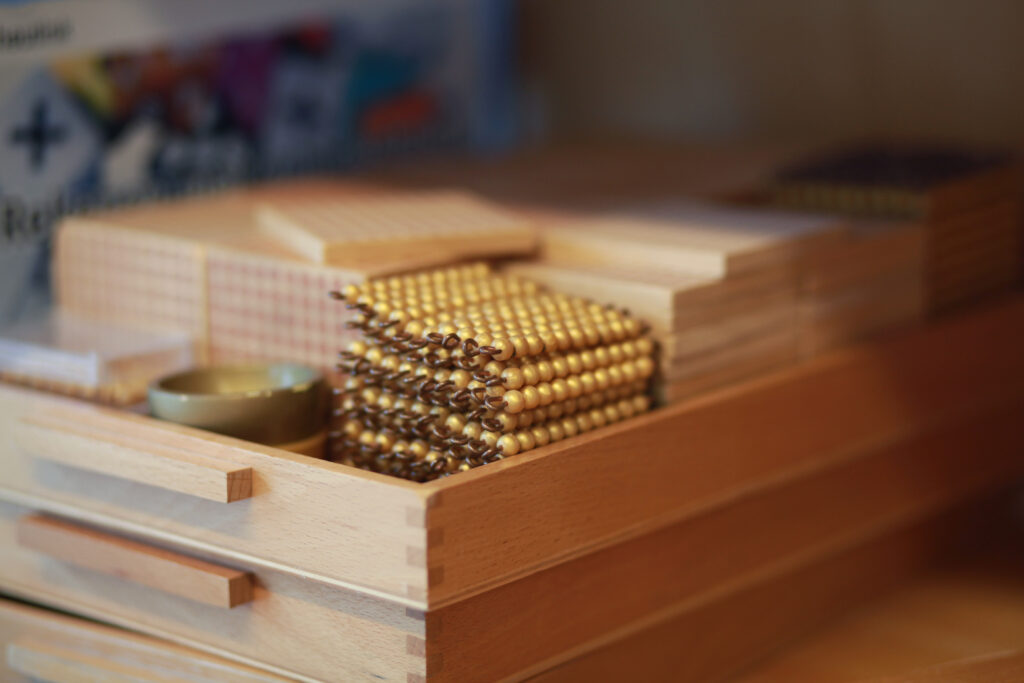Montessori math activities are designed to give children a sensorial impression of mathematic concepts. The Montessori Change Game is a great example of this.
This fun, engaging Montessori activity teaches young children important math skills they will carry with them throughout their educational careers and on into their adult lives.
In this article, you will learn what the Change Game is, its purpose, and how to present this activity to a child.

(This post contains affiliate links. Purchasing from these links costs you nothing extra, but helps with our website upkeep.)
What is the Montessori Change Game?
The Montessori Change Game, also called the Exchange Game, is a classic Montessori math activity.
The purpose of the Change Game is to give children the opportunity to experience how small quantity categories can be exchanged for larger quantity categories and still total the same amount.
This math game not only prepares children for work with the decimal system, but it reinforces the concept of 1:1 correspondence and the idea that things can be exchanged for other things, as well as be repurposed, which is an important cosmic lesson.
If you are planning on sending your child to a public school, math activities such as this one will help acclimate them to Common Core Standards, as well.
This activity incorporates fine motor development through the manipulation of the Golden Bead Material.
- Montessori beads are made of high-quality environmentally…
- 100 unit beads, 45 bars of 10, 45 squares of 100,9 cubes of…
- Used in math activities to help kids understanding the Addition…
Gross motor movements were also planned for in the development of this activity. You will notice that the child must move around quite a bit and walk to and from the shelf and the floor mat.
While adults may see this as a wasted expenditure of energy, a young child needs frequent breaks for these large-muscle movements to help them better concentrate on their work.
Aim of the Montessori Change Game
- to get hands-on experience with the decimal system, specifically the order effect
- to learn about exchanging ten of one category for one of another category
Indirect aim
- preparation for dynamic math equations
How to present the Change Game
Materials
- Large quantity of Golden Bead Material (at least 10 units, 10-tens bars, and 10 hundred's squares, and no more than 9 thousands cubes should be on the tray)
- Felt-lined wooden tray with a smal bowl
- Large work mat
Control of error
- the adult
- the child's ability to count
Presentation
- Invite the child to gather a good amount of Golden Bead Material from various quantity categories from the Golden Bead Bank, place it on a tray, and carry the tray to a large work mat on the floor. (You may prepare the tray ahead of time to ensure you have everything you will need.)
- Ask the child if they would like to help you tally the total quantity of Golden Beads on the tray.
- Have the child remove the material from the tray and sort it into categories, thousands to the laft and units to the right.
- Ask the child to count the beads starting with the units. When 10 unit beads have been counted, say, “These 10 beads are the same as what? What can we exchange them for?”.
- Give the child as much time as they need to come up with the answer (one 10-bar) and confirm that they are correct.
- Have the child place the ten units in the bowl, one-by-one, and carry the tray to the Golden Bead bank on the shelf and exchange them for a 10-bar.
- Have the child place the 10-bar on the work mat with the other 10-bars and continue counting the unit beads.
- If there are again 10 unit beads, have the child repeat the process. If there are less than 10 unit beads left, inform the child that an exchange cannot be made.
- Invite the child to count the 10-bars on the mat.
- When the child has counted ten 10-bars, have them carry them on the tray to the Golden Bead bank and exchange them for a 100-square and place it one the mat with the other 100-squares.
- Again have the child continue counting 10-bars and exchanging them for 100-squares until there are less than ten 10-bars left.
- Reapeat this process with the 100-squares, exchanging them for thousand cubes.
- When all possible exchanges have been made, keeping the bead material separated into categories, call out the total number by catergory. For example, if the quantity is 9,284, you would say, “9 thousands, 2 hundreds, 8 tens, and 4 units. This is also called nine-thousand, two-hundred, and eighty-four.”
- Have the child return the material to the shelf and let them know they can play the Change Game whenever they please.
Extensions
- Reverse exchanges (breaking down 100-cubes for ten 10-bars, for example) to prepare a child for dymanic subtraction.
- Using Large Number Cards along with the beads
- Involve multiple children in the game and have them work as a team to make the exchanges.
The Montessori Change game is a fun way for children to learn the concept of the decimal system. By making the exchanges, they are getting a hands-on experience without even realizing it.
Have you presented this Montessori activity in your home?
Cheers and don't forget to subscribe!

